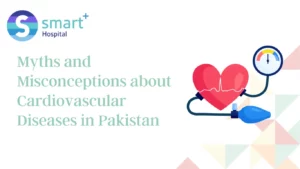Heart disease are among the leading causes of death worldwide, taking an estimated 17.9 million lives yearly. In Pakistan, heart disease has witnessed an alarming rise, making it pivotal to understand and acknowledge its prevalence.
Pakistan is ranked #30 globally, with a death rate of 193.56 per 100,000 people. Keep reading to know different types of heart disease, their symptoms and how to prevent them
1. Ischemic Heart Disease (Coronary Artery Disease)
Ischemic heart disease, commonly known as coronary artery disease, is caused by narrowed heart arteries, reducing blood flow to the heart muscle.
As of 2020, ischemic heart disease was responsible for approximately 17% of all deaths in Pakistan, making it the leading cause of mortality. Sedentary lifestyles and a rise in tobacco consumption have been significant contributing factors.
Symptoms:
The most common symptom of IHD is angina, a chest pain or discomfort that typically occurs with exertion and goes away with rest. Other symptoms include:
- Chest pain or discomfort
- Shortness of breath
- Fatigue
How to prevent Ischemic heart disease?
Regular exercise, a balanced diet, and regular health check-ups can help mitigate the risk.
2. Heart Failure
Heart failure doesn’t mean the heart stops beating. Instead, it’s a condition where the heart doesn’t pump blood as well as it should, leading to a shortage of blood flow to other organs.
Pakistan has witnessed a rise in heart failure cases, with factors like uncontrolled hypertension and diabetes playing major roles. Access to timely medication and treatment remains challenging for many in rural areas.
Symptoms:
- Fatigue
- Swollen ankles, legs, and abdomen
- Rapid heartbeat
How to avoid heart failure?
Preventing rheumatic fever is the most effective way to prevent RHD. This can be achieved by:
- Promptly treating streptococcal infections with antibiotics.
- For those who have had rheumatic fever before, long-term or recurrent courses of antibiotics might be prescribed to prevent recurrence.
In recent years, efforts have been made globally to increase awareness, improve prevention, and enhance access to treatment for RHD, especially in areas where the disease remains prevalent.
3. Rheumatic Heart Disease
Rheumatic heart disease results from untreated or inadequately treated strep throat or scarlet fever. It can lead to heart valve damage.
Rheumatic heart disease is a concern in Pakistan, especially among children. Delayed diagnosis and limited access to healthcare in certain regions aggravate its prevalence.
Symptoms
- fever
- painful joints, especially knees, ankles, elbows and wrists
- fatigue
- heart murmur
It is important to prevent rheumatic fever from occurring because rheumatic heart disease is caused by rheumatoid arthritis. Antibiotic therapy for strep throat will prevent strep throat from causing rheumatoid arthritis.
4. Hypertensive Heart Disease
Hypertension affects an estimated 33% of the adult population in Pakistan. It originates from prolonged high blood pressure and causes heart failure, thickening of the heart muscle, and coronary artery disease.
Urbanisation, increased salt intake, and sedentary habits contribute to its growing incidence.
Symptoms
- Shortness of breath
- Fatigue
- Irregular heartbeats
- Chest pain
- Swelling in the legs and ankles (oedema)
- Weight gain
This condition often goes unnoticed due to its asymptomatic nature, making it a silent killer. However, you can take the following steps to prevent hypertensive heart disease.
- Lifestyle changes: Reducing salt intake, regular exercise, maintaining a healthy weight, and reducing alcohol and tobacco use.
- Medication: There are many types of drugs available to lower blood pressure, including diuretics, ACE inhibitors, beta-blockers, and calcium channel blockers.
- Monitoring: Regular medical check-ups are essential to monitor blood pressure and assess the condition of the heart.
5. Congenital Heart Disease
Congenital Heart Disease (CHD) refers to structural abnormalities of the heart at birth. These defects can involve the heart’s walls, valves, arteries, and veins. Close to 1% of newborns are diagnosed with some form of CHD.
Every year, about 40,000 children are born with a congenital heart defect in Pakistan. Only a fraction receive the necessary surgical interventions due to limited healthcare resources.
Symptoms
- Rapid breathing or breathlessness
- Fatigue (especially during physical activity)
- Blue-tinted skin, lips, and nails (known as cyanosis)
- Chest pain
- Swelling in the extremities, abdomen, or around the eyes
It’s not always possible to prevent congenital heart disease. However, there are some steps that pregnant women can take to reduce the risk of their babies developing these conditions:
- Pre-Pregnancy Health Check: Women should consider a health check-up before becoming pregnant. For example, diabetes should be well-managed before and during pregnancy to decrease the risk of congenital heart defects.
- Take Prenatal Vitamins: Folic acid, taken before and during early pregnancy, can help prevent major birth defects in the baby’s brain and spine.
- Maintain a Healthy Weight: Being overweight increases the risk of several complications during pregnancy, including the potential for congenital heart defects. A balanced diet and regular physical activity help maintain a healthy weight.
FAQs
Q1: Is heart disease hereditary?
Ans: Genetics can play a role in certain heart conditions. However, lifestyle and environmental factors are often major contributors.
Q2: What is the leading cause of heart disease in Pakistan?
Ans: Lifestyle factors like poor diet, sedentary behaviour, smoking, and genetic predispositions, play significant roles.
Q3: How can one prevent heart disease?
Ans: Regular medical check-ups, maintaining a balanced diet, engaging in physical activity, and avoiding smoking can drastically reduce the risk.
Q4: What age group is most affected by heart disease in Pakistan?
Ans: Although heart disease is commonly associated with the elderly, the younger population is increasingly at risk due to lifestyle factors and hereditary conditions.
Q5: Are there any national campaigns or programs in Pakistan targeting heart disease?
Yes, the National Action Plan for Prevention and Control of Non-Communicable Diseases and Health aim to raise awareness, enhance medical facilities, and provide treatments to those in need.
Q6. Why is IHD so common in Pakistan?
Ans: Due to a sedentary lifestyle and other risk factors such as heavy smoking, deaths from cardiovascular disease in the age group of 30 to 40 years are becoming more common in Pakistan.
Q7. Can heart disease be completely cured?
Ans: While some conditions can be managed or reversed with lifestyle changes and medications, others, like certain congenital heart defects, might require surgical intervention.





Pingback: Cardiac Rehab: Phases and Exercises to Help Your Heart - Smart Hospital